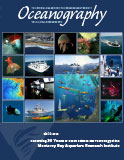Article Abstract
Roughly 25 years ago, “ecogenomic sensors” were conceived of as autonomous devices that would be used to apply molecular analytical techniques below the sea surface as one part of a futuristic, integrated ocean observing system. The Environmental Sample Processor (ESP) was built to address that idea—an instrument to help define both the technological and operational elements that underlie the ecogenomic sensor concept. Over time, the ESP emerged as a working example of that class of instrument, enabling the application of DNA probe and protein arrays as well as use of the quantitative polymerase chain reaction (qPCR) technique to assess the presence and abundance of a wide range of organisms, specific genes, and metabolites. The ESP is also used to preserve samples for a variety of laboratory tests not yet possible to carry out in situ (e.g., DNA sequencing). The instrument has been deployed on a variety of platforms, including coastal moorings, piers, an open ocean drifter, research vessels, a shallow water benthic lander, and a 4,000 m rated “elevator” designed for use on deep-sea cabled observatories. A new version of the ESP is currently being developed for use aboard an autonomous underwater vehicle. This article traces the evolution of the ESP from its conception to present-day status.

